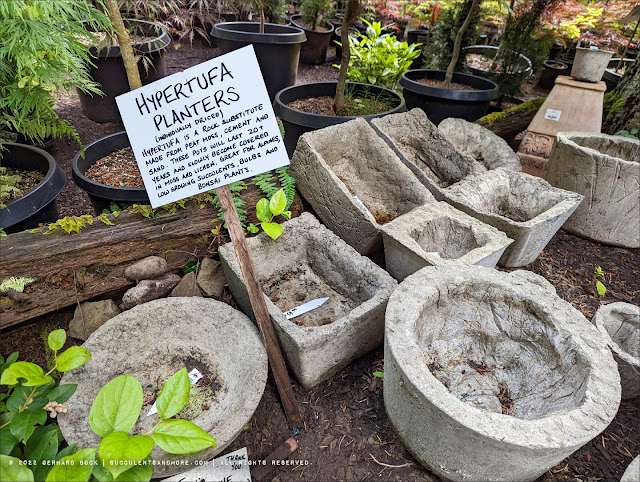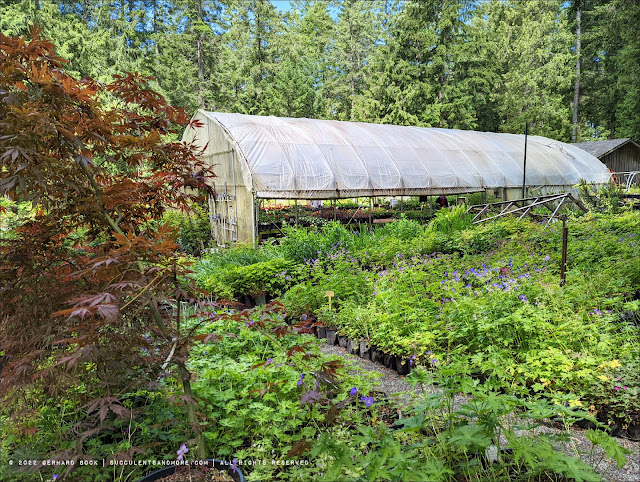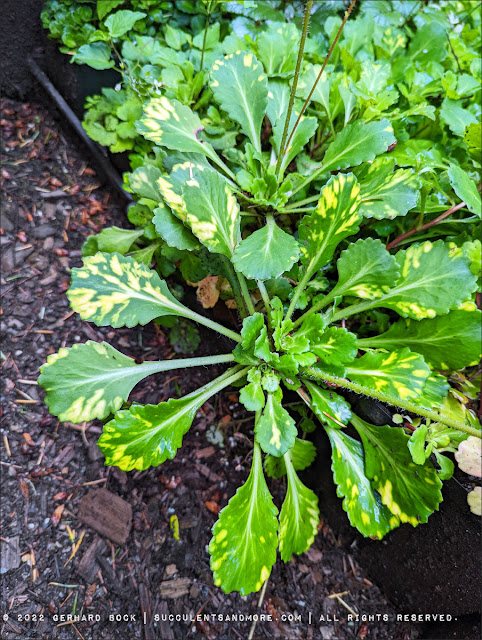On our trip to Victoria, British Columbia in June, we spent a couple of days on Salt Spring Island. It’s the largest of the Gulf Islands, located in the Strait of Georgia just off Vancouver Island (see maps at the end this post). Salt Spring Island is easy to reach via ferry from Swartz Bay, just north of the Victoria airport. The ferry ride takes about 35 minutes.
Salt Spring Island has a population of approx. 12,000. About half of the residents live in Ganges, the largest settlement. It’s home to most of the island’s shops, galleries, and restaurants as well as its colorful and well-attended Saturday market where you can buy anything from arts and crafts, clothing, crystals and other New Age imponderabilia to the freshest fruits, vegetables, and baked goods imaginable.
When my friend Dan, who grew up in Victoria, found out that we were going to Salt Spring Island, he told me we had to visit Fraser’s Thimble Farms, a destination nursery on the northern tip of the island specializing in rare and unusual plants. As a teen, Dan used to save up his paper route money to buy terrestrial orchids there.
Fraser’s Thimble Farm is located on a small peninsula jutting out into Southey Bay. It’s nestled into the forest so you can’t see the water, but the nursery is literally just 300 ft. from the shoreline.
At first glance, Fraser’s Thimble Farm may look like a regular nursery catering to local residents, but that’s just the front of the house, so to speak. The nursery also carries a wide range of rarities, including hardy orchids (especially Cypripediums) and seldom seen plants from the temperate regions of Asia. In the past, Fraser’s Thimble Farm used to do mail order as well but that part of the business has been shut down, at least temporarily, because of a lack of available labor. Only bulbs are still being shipped—but the
bulb list is massive.
Let’s go explore the 3 acres of nursery grounds...
 |
| The nursery wasn’t busy when we were there. Maybe people don’t do a lot of planting in June, although the climate on Salt Spring Island is mild enough to garden year round. |
 |
| I always look at the ingredients of local compost. I’d buy this product in a heartbeat if it were available in our area. |
 |
| Some people react negatively to signs telling them what to do (or not to do). Me, I appreciate the owners being up front. |
 |
| Hypertufa planters made right at the nursery. Too heavy to take on the plane, unfortunately. |
 |
| Path up to the nursery office |
 |
| I didn’t pet the nursery dog, although it looked friendly enough to me |
 |
| Shrubs and trees are clearly a mainstay at the nursery |
 |
| They carry a huge selection |
 |
| Hoop house with tender plants |
 |
| Inside the hoop house |
 |
| Annuals and perennials |
 |
| Westcountry™ lupine, tissue-cultured selections of Lupinus polyphyllus from Westcountry Nurseries in the UK. Look at how massive the flower spikes are! |
 |
| My mother-in-law was quite taken with them |
 |
| Aquatic plants, too—no surprise, considering how much it rains on Salt Spring Island (about 40" a year) |
 |
| This primula may not look special, but it reminded me of the primulas growing wild where I grew in Germany |
 |
| More shrubs... |
 |
| ...and trees |
 |
| Plenty of monkey puzzle trees (Araucana araucaria) in sizes ranging from small starts.. |
 |
| ...to larger juveniles... |
 |
| ...to plants that are a good 10 years old |
 |
| And of course ferns, in the ground and in containers for sale |
 |
| Palm trees, too |
 |
| Himalayan blue poppies (Meconopsis × shelldonii), my holy-grail plant |
 |
| Blue poppies have an unearthly beauty and are utterly unique |
 |
| Back 40 of the nursery |
 |
| This is where most of the rare and unusual plants are |
 |
| Needless to say most of them were completely unfamiliar to me |
 |
| This is what you get when you have 40" of rainfall a year! |
 |
| Hoop house from the back |
 |
| I loved this sign |
 |
| These spring ephemerals didn’t look all that dormant |
 |
| Formosan lady’s slipper orchid (Cypripedium formosanum) |
 |
| Pink slipper orchid (Cypripedium acaule) |
 |
| Podophyllum ‘Spotty Dotty’ |
 |
| Paris polyphylla |
 |
| Syneilesis palmata |
 |
| Syneilesis aconitifolia |
 |
| Saxifraga umbrosa ‘London Pride’ |
 |
| Filipendula palmata ‘Variegata’ |
 |
| Strange to see agaves in a sea of plants that clearly need moist conditions to thrive |
 |
| Needless to say Salt Spring Island isn’t the best climate for agaves |
 |
| Opuntia fragilis, surprisingly, is native to much of the western US as well as some Midwestern states (Illinois, Iowa, Wisconsin and Michigan) and even some Canadian provinces |
 |
| Bunny ears (Opuntia microdasys), on the other hand, won’t survive outside |
As promised here are a couple of maps courtesy of Google that give you a better idea where Salt Spring Island and Fraser’s Thimble Farm are located:
If you ever find yourself on Salt Spring Island and want to visit the nursery,
check their website for directions and hours.
© Gerhard Bock, 2022. All rights reserved. To receive all new posts by email, please subscribe here.



















































"Nestled into the forest... just 300 ft. from the shoreline..." describes a heavenly nursery location to visit. I always drool over Himalayan blue poppies. Podophyllum ‘Spotty Dotty’ and Syneilesis aconitifolia too are drool worthy, though shady areas in my garden are hard to find.
ReplyDeleteThe monkey puzzle I grow in a pot must be 10 years old. Let's not get to 20 before you come to it up :-D
(I'm kidding, of course. I'll love it for as long as it takes.)
Chavli
What fun! I have heard of this place, but really had no idea what they were all about.
ReplyDeleteThe nursery and in-ground plantings look so lush, I had to check their climate -- do they have 40 inches of rain dispersed year-round? No, apparently, SSI is summer-dry too. I know some kids that grew up on this island, which sounds idyllic, but of course they couldn't wait to leave! When they're older, I bet they'll miss it terribly...
ReplyDeleteIronic that I spent a lot of time on Salts Spring but never visited the nursery. Must put it on my bucket list though I don't think many of those plants would survive in my semi-desert garden now.
ReplyDelete